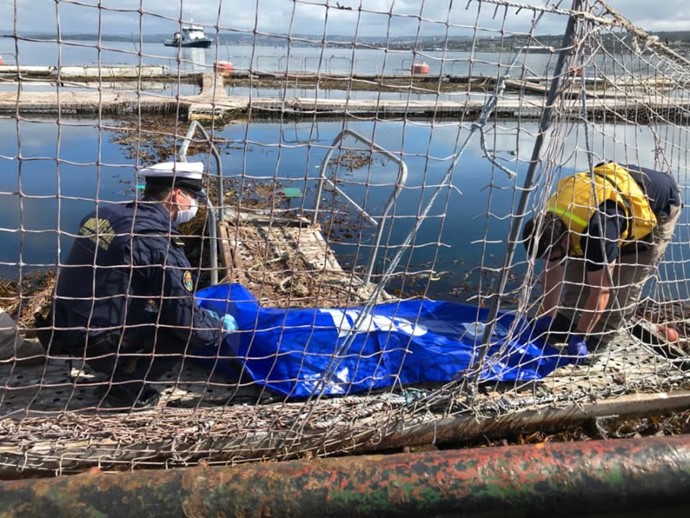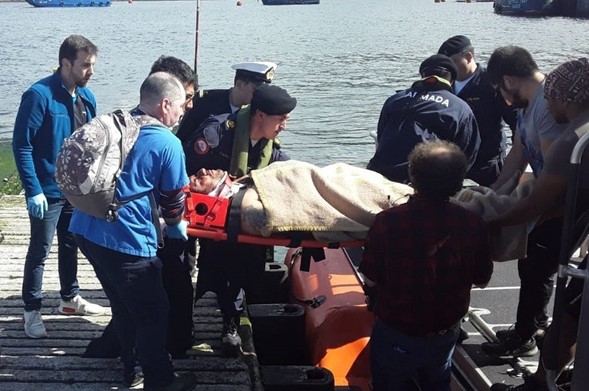In these turbulent days for the people of Tierra del Fuego due to the presidential decree that jeopardizes the private sector's largest employers, a possible solution is being sought from the very person who created the problem. A sort of US pharmaceutical company introducing a disease into a South American country and then selling the drug. A profitable business for a few, a detriment to thousands.
In Tierra del Fuego, AeIAS (Argentine Fisheries and Aquaculture Institute) in 2021, Law No. 1355 prohibited the installation of salmon cages in all maritime and lake areas . It was thanks to the conscience of the people of Tierra del Fuego who rejected this extractive industry in light of its production in Chile and other parts of the world. Argentina thus became the first country to ban this activity.
This time, the provocation does not come from the Kingdom of Norway - which in 2018 gave the first indication that they want to install salmon cages in the sea and lakes in our province - but rather from the owner of Newsan, Rubén Cherñajovsky, who in June 2024 presented the idea of his new business : the installation of salmon farms on our large island.
Following this confession, legislators from the Libertad Avanza party and others from the Tierra del Fuego ruling party, along with trolls and the national media, immediately began to pressure for the amendment or repeal of the law passed just four years ago. This is no coincidence, given that it is now gaining momentum in the face of the threat of thousands of job losses.
In this context, Governor Gustavo Melella, in an article in Clarín He said he is working to enable the installation of salmon cages on the Atlantic coast and that he is "aware" of the environmental impact, but given the pressing threat from the national government, he is committed to creating jobs with this industry.
We don't know why Melella made a U-turn , but it must be understood that the logic of extractive industrial models is a huge fallacy, as it tends to concentrate profits in a few hands, generate few jobs, and create precarious work.
Work, what work?
It is necessary to highlight the article generated by professors from the National University of Tierra del Fuego, UNTDF, Analysis of Large-Scale Intensive Salmonid Aquaculture in the Beagle Channel as a Strategy for the Development of Tierra del Fuego (2019), where they conclude the difficulty and risk of installing this extractive industry in the province for environmental reasons, lack of regulatory frameworks and, above all, the State's inability to control this industry.

Their analysis takes into account the Chilean experience, which, while successful in terms of economic growth and productive diversification, reveals serious unresolved problems: environmental disasters, persistent social conflicts, and the failure to build a regulatory and institutional framework that guarantees sustainability. This precedent is a key warning for the province, where the risks could even be amplified by the difficulty of state control.
As a way of sparking an urgent debate, this note will highlight labor issues over environmental and economic issues.
According to the authors of the scientific text , on the large island of Tierra del Fuego, production is estimated at 20,000 to 30,000 tons/year and following the employment model according to the most important company in the Magellanic region, Nova Austral (a company that still operates despite having (trial for pollution and fraud against the Chilean State), 15 people would be employed per production center (salmon farms at sea): 3 professionals to cover the roles of concession manager, environmental manager, and management manager; 1 center manager and 2 assistants, with engineering or biologist profiles specializing in aquaculture; 4 technicians; and approximately 5 low-skilled workers.
They conclude that, based on the potential installation load of these fattening cages in the Beagle Channel, they would generate only 75 jobs, most of which are skilled jobs.
The authors also reveal the research carried out by Jorge Dresdner and others (2017), which taking the SERNAPESCA database (Chile) for 2014 in the Magallanes region , 2.61 jobs were generated per ton produced.
Considering these references, with the estimated exploitation potential of 30 thousand tons of transgenic salmon ( it is estimated that to reach that production it could take between 5 to 12 years ), between 120 to 180 cages would be installed, which means approximately 12 to 18 production centers, it could be estimated from 180 to 270 direct jobs (including professionals, technicians and operators).
Since it will take a long time to export that amount of tons, the jobs created will be much fewer.
The labor model
The Chilean salmon farming labor model has precarious standards, since labor costs, if they met European standards, would make exports difficult.
Data on the extractive model of salmon farming:
l The price varies according to demand and quality, which puts jobs at risk when the price per kilo of salmon drops;
l In Chile, there is a phenomenon of increasing structural unemployment as a result of the technologization of administrative, productive and logistical processes.
l Not counting the processing plant, which is generally located far from salmon breeding sites, employment contracts are mostly temporary (specialized divers, contracts for harvesting, sowing, cage cleaning, with higher demand in summer and autumn (harvest cycles).
l Jobs depend on environmental and health variables. An example is what happened between 2007 and 2010 in Chile, where the ISA virus affected most cages, affecting more than 50% of direct jobs.
l In the case of salmon “escape,” the number of jobs directly related to feeding, antibiotic administration, logistics, slaughter, etc., decreases;
l Seventy percent of employees are men, the other 30% are women, who mostly occupy professional positions (scientists, accountants, lawyers); women earn on average approximately 20% less than men in the sector (INACAP), 2023
l The salaries of senior managers and those working in the operational department are disproportionately high.
l It's a job with a high risk of death and serious accidents. According to research by Ecóceanos, between 2013 and the first three months of 2024, a total of 80 worker deaths have been recorded in the salmon industry. Of this figure, 22 deaths have been reported between 2021 and 2023 alone, averaging 7.3 worker deaths per year .

l The average annual salary for permanent operational staff is $729. Most temporary jobs earn only $450.
l Wages are subject to seasonality (production slows down in autumn/winter) and to productivity bonuses that require people to work grueling days of more than 12 hours to compensate for low wages . Nearly 30% of wages depend on the production bonus, unlike in Norway, where it is only 3.3%. .
l Without a doubt, working in cold and humid environments is one of the most critical ergonomic problems affecting salmon farms .
l Poisoning from agents such as pesticides, sanitizers, and insecticides is common , as are conditions such as lumbago and sciatica, caused by the excessive load carried by some workers, especially when feeding salmon.
Without comparing this task with other activities that can generate jobs, this Newsan project -and who knows how many other people or nations are behind the desire to repeal Law 1355-, we can see that the establishment of the salmon industry, as well as other extractive industries, does not fit the golden promise of generating jobs that compensate for the loss of jobs in the electronics industry, which directly employs more than 7,000 people.
All of this without considering the significant environmental and economic impact of salmon farming on an industrial scale. That will be part of another installment.


